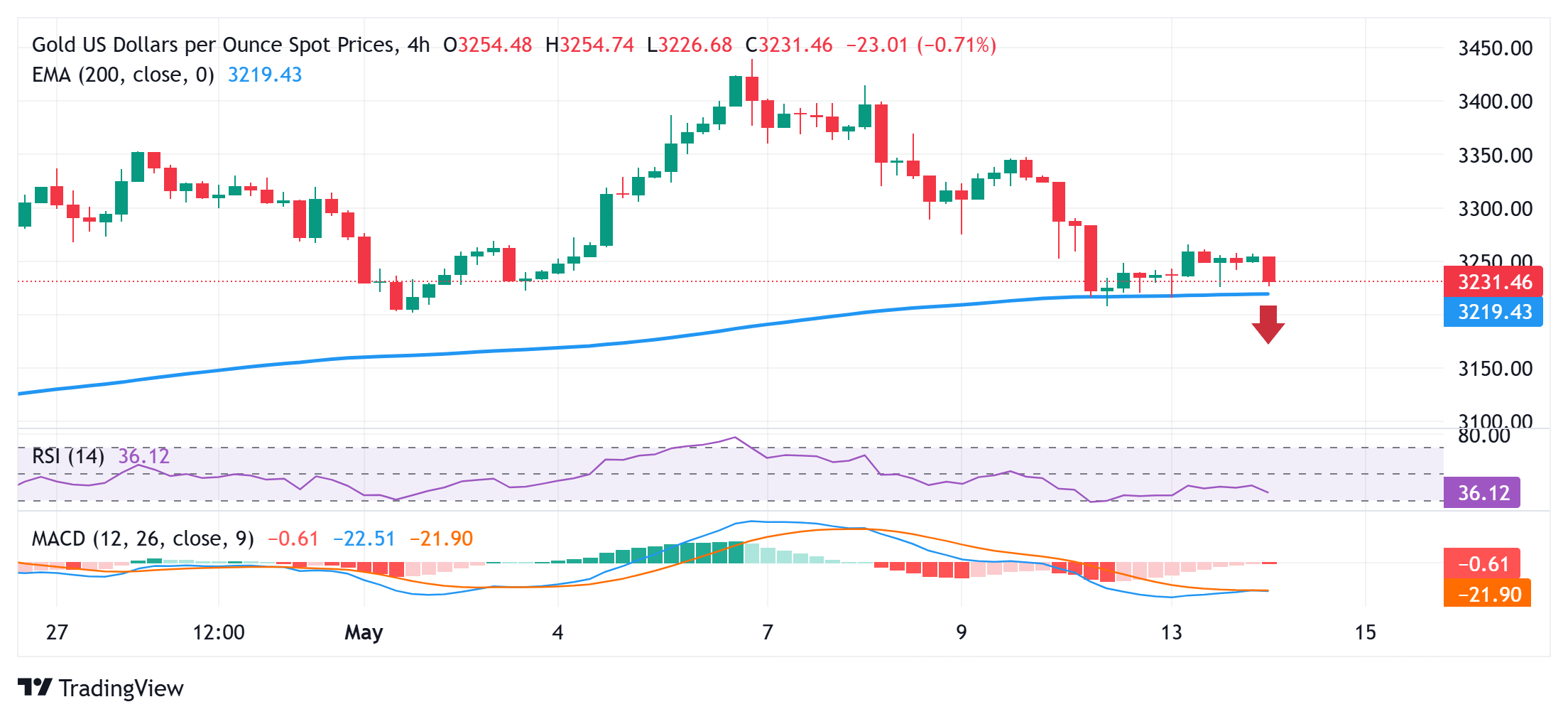Gold price bears flirt with 200-period EMA pivotal support on H4 amid US-China trade optimism
- Gold price drifts lower as the US-China trade truce optimism undermines safe-haven demand.
- Tuesday’s US CPI print reaffirms Fed rate cut bets and keeps the USD bulls on the defensive.
- Geopolitical risks could limit deeper losses for the XAU/USD pair, warranting caution for bears.
Gold price (XAU/USD) struggles to capitalize on the previous day's modest uptick and attracts fresh sellers during the Asian session on Wednesday. The latest optimism over the de-escalation of a potentially damaging trade war between the US and China – the world's two largest economies – remains supportive of a generally positive tone around the equity markets. This, in turn, undermines demand for traditional safe-haven assets and keeps the precious metal well within striking distance of the weekly low touched on Monday.
Meanwhile, the softer-than-expected inflation data from the US released on Tuesday reaffirmed market bets for at least two interest rate cuts by the Federal Reserve (Fed) in 2025. This led to the overnight US Dollar (USD) pullback from its highest level since April 10, set earlier this week, and could help limit deeper losses for the non-yielding Gold price. Hence, it will be prudent to wait for strong follow-through selling and a convincing break below the $3,200 mark before positioning for any further losses for the XAU/USD pair.
Daily Digest Market Movers: Gold price continues to be pressured by trade optimism
- US President Donald Trump said on Monday that he does not see tariffs on Chinese imports returning to 145% after the 90-day pause. In a Fox News interview earlier this Wednesday, Trump said that the relationship with China is excellent, adding to the trade optimism and undermining the safe-haven Gold price during the Asian session.
- On the geopolitical front, Russia and Ukraine are set for their first high-level face-to-face talks since 2022 in Istanbul this week amid increasing demand for Russia to agree to a 30-day ceasefire. On the US side, Secretary of State Marco Rubio and special envoys Steve Witkoff and Keith Kellogg are expected to attend the negotiations.
- The Israeli military said it intercepted a hypersonic ballistic missile fired by the Iran-aligned Houthis militia group towards Ben Gurion Airport near Tel Aviv from Yemen on Tuesday evening. This keeps geopolitical risks in play and might hold back traders from placing aggressive bearish bets around the XAU/USD pair.
- The US Bureau of Labor Statistics (BLS) reported that the headline Consumer Price Index (CPI) edged lower to the 2.3% YoY rate in April from 2.4% in the previous month. Meanwhile, the core CPI, which excludes volatile food and energy prices, matched consensus estimates and rose 2.8% on a yearly basis in April.
- Traders are still pricing in the possibility that the Federal Reserve will lower borrowing costs by 56 basis points in 2025. This fails to assist the US Dollar to attract any meaningful buyers following Tuesday's pullback from a one-month high and should contribute to limiting deeper losses for the non-yielding yellow metal.
- There isn't any relevant market-moving economic data due for release from the US on Wednesday, leaving the USD at the mercy of scheduled speeches from Fed officials. Apart from this, the broader risk sentiment will play a key role in producing short-term trading opportunities around the commodity.
Gold price could accelerate the fall once the 200-period EMA on H4 is broken decisively

From a technical perspective, the XAU/USD pair has been showing some resilience near the 200-period Exponential Moving Average (EMA), currently pegged near the $3,225 region, on the 4-hour chart since the beginning of this week. Given that oscillators on the daily chart have just started drifting in negative territory, a convincing break below the said support will be seen as a fresh trigger for bearish traders. A subsequent fall below the $3,200 round figure will confirm a fresh breakdown and make the Gold price vulnerable to resume its recent corrective slide from the $3,500 psychological mark, or the all-time peak touched in April. The commodity might then accelerate the fall towards testing the next relevant support near the $3,135 area.
On the flip side, the overnight swing high, around the $3,265-3,266 region, now seems to act as an immediate hurdle, above which the Gold price could aim to reclaim the $3,300 mark. Some follow-through buying and a move beyond the weekly high, around the $3,317-3,318 zone, might shift the bias in favor of bullish traders and lift the Gold price to the $3,345-3,347 hurdle en route to the $3,360-3,365 static barrier. A sustained strength beyond the latter will set the stage for a move towards the $3,400 round figure.
Risk sentiment FAQs
In the world of financial jargon the two widely used terms “risk-on” and “risk off'' refer to the level of risk that investors are willing to stomach during the period referenced. In a “risk-on” market, investors are optimistic about the future and more willing to buy risky assets. In a “risk-off” market investors start to ‘play it safe’ because they are worried about the future, and therefore buy less risky assets that are more certain of bringing a return, even if it is relatively modest.
Typically, during periods of “risk-on”, stock markets will rise, most commodities – except Gold – will also gain in value, since they benefit from a positive growth outlook. The currencies of nations that are heavy commodity exporters strengthen because of increased demand, and Cryptocurrencies rise. In a “risk-off” market, Bonds go up – especially major government Bonds – Gold shines, and safe-haven currencies such as the Japanese Yen, Swiss Franc and US Dollar all benefit.
The Australian Dollar (AUD), the Canadian Dollar (CAD), the New Zealand Dollar (NZD) and minor FX like the Ruble (RUB) and the South African Rand (ZAR), all tend to rise in markets that are “risk-on”. This is because the economies of these currencies are heavily reliant on commodity exports for growth, and commodities tend to rise in price during risk-on periods. This is because investors foresee greater demand for raw materials in the future due to heightened economic activity.
The major currencies that tend to rise during periods of “risk-off” are the US Dollar (USD), the Japanese Yen (JPY) and the Swiss Franc (CHF). The US Dollar, because it is the world’s reserve currency, and because in times of crisis investors buy US government debt, which is seen as safe because the largest economy in the world is unlikely to default. The Yen, from increased demand for Japanese government bonds, because a high proportion are held by domestic investors who are unlikely to dump them – even in a crisis. The Swiss Franc, because strict Swiss banking laws offer investors enhanced capital protection.

